Help Please - Cuphea h.
+4
Xavier de Lapeyre
bonsaisr
Billy M. Rhodes
Khaimraj Seepersad
8 posters
Page 1 of 2
Page 1 of 2 • 1, 2 
 Help Please - Cuphea h.
Help Please - Cuphea h.
Anyone done work with Cupheas ?
I have this dream of a 1 or 2 inch [ 2.5 to 5 cm ] thick trunk cuphea ?
Years ago, I was at an elderly friend's home. She had Cupheas in the ground with thick trunks. Ma as she was called, allowed me to take one, but it didn't survive the transfer. She's gone some 10 years now, her garden plot was dug up and the plants replaced.
I am seeing today, what looks like another cultivar, with thicker trunks, but the same small leaves and beautiful flowers.
Here is one I saved an image of.
Anyone else working on Cupheas ?
Khaimraj

I have this dream of a 1 or 2 inch [ 2.5 to 5 cm ] thick trunk cuphea ?
Years ago, I was at an elderly friend's home. She had Cupheas in the ground with thick trunks. Ma as she was called, allowed me to take one, but it didn't survive the transfer. She's gone some 10 years now, her garden plot was dug up and the plants replaced.
I am seeing today, what looks like another cultivar, with thicker trunks, but the same small leaves and beautiful flowers.
Here is one I saved an image of.
Anyone else working on Cupheas ?
Khaimraj


Khaimraj Seepersad- Member
 Re: Help Please - Cuphea h.
Re: Help Please - Cuphea h.
The University of Florida says this about what is known in the nursery trade here in Florida as Mexican or Florida Heather. I post it because on of the other varieties of Cuphea mentioned below might develop better trunks.
Today’s plant is more properly called False Mexican Heather (Cuphea hyssopifolia) to distinguish it from other plants named heather. It is native to Mexico, Guatemala, and Honduras. Originally introduced as a seed oil producing plant, it is now fairly common in local landscapes. They are small shrubby plants with white, pink or lavender colored flowers and readily available in local garden centers.
These distant cousins of Crepe Myrtle are known for their abundant flowers. Cupheas (coo-FEE-ahs) may last for several growing seasons in our landscapes. With small dense, green foliage, they grow up to two feet high. This plant forms flat-topped mounds and works well when many plants are massed together. Mexican Heather is used as a flowering perennial in warmer areas, but can be used as an annual in areas where it will be killed back by a freeze.
Occasionally, the seedlings will pop up outside the plant beds in our Florida Yards. It should be watched to keep it in bounds: in Hawaii and Puerto Rico, it has escaped into natural areas.
Santa Rosa County Extension Agent Theresa Friday tells me that there are several other species and as many as 40 cultivars of Cupheas. They have tubular flowers that make them attractive to hummingbirds and butterflies. Their odd-shaped flowers give us some unusual common names - here are some of the most commonly used ornamental Cupheas:
The Bat-faced Cuphea (C. llavea) is named for its unusual flowers, which look like the face of a bat in shades of purple and scarlet red. It’s easy to grow, is low maintenance, drought-tolerant, and heat loving. This is one plant that children will love looking at: the flowers will remind them of Mickey Mouse, and Disney makes use of them in their Orlando landscapes.
The Cigar Flower or Cigarette Plant (C. ignea) has brilliant orange flowers. The flowers are skinny and tubular. This plant will typically grow to be about three feet high with a similar spread. The leaves are dark green and lance shaped.
Giant Cigar Flower or Candy Corn Plant (C. micropetala) has magnificent orange and yellow flowers. This is one of the largest Cupheas and will reach five to six feet in height with a spread of three to four feet. While other Cupheas are year-round bloomers, this one will flower in the fall.
Growing Heather in Florida Yards
False Heather grows in bright light to partial shade, but more flowering occurs under brighter light conditions. Choose places with well drained soil. Root rot is a problem when Mexican Heather is kept too moist or if planted too deep. It also has poor salt tolerance, so be careful when using well water sources for irrigation. On the plus side: Texas A&M suggests it has good resistance to deer grazing.
Today’s plant is more properly called False Mexican Heather (Cuphea hyssopifolia) to distinguish it from other plants named heather. It is native to Mexico, Guatemala, and Honduras. Originally introduced as a seed oil producing plant, it is now fairly common in local landscapes. They are small shrubby plants with white, pink or lavender colored flowers and readily available in local garden centers.
These distant cousins of Crepe Myrtle are known for their abundant flowers. Cupheas (coo-FEE-ahs) may last for several growing seasons in our landscapes. With small dense, green foliage, they grow up to two feet high. This plant forms flat-topped mounds and works well when many plants are massed together. Mexican Heather is used as a flowering perennial in warmer areas, but can be used as an annual in areas where it will be killed back by a freeze.
Occasionally, the seedlings will pop up outside the plant beds in our Florida Yards. It should be watched to keep it in bounds: in Hawaii and Puerto Rico, it has escaped into natural areas.
Santa Rosa County Extension Agent Theresa Friday tells me that there are several other species and as many as 40 cultivars of Cupheas. They have tubular flowers that make them attractive to hummingbirds and butterflies. Their odd-shaped flowers give us some unusual common names - here are some of the most commonly used ornamental Cupheas:
The Bat-faced Cuphea (C. llavea) is named for its unusual flowers, which look like the face of a bat in shades of purple and scarlet red. It’s easy to grow, is low maintenance, drought-tolerant, and heat loving. This is one plant that children will love looking at: the flowers will remind them of Mickey Mouse, and Disney makes use of them in their Orlando landscapes.
The Cigar Flower or Cigarette Plant (C. ignea) has brilliant orange flowers. The flowers are skinny and tubular. This plant will typically grow to be about three feet high with a similar spread. The leaves are dark green and lance shaped.
Giant Cigar Flower or Candy Corn Plant (C. micropetala) has magnificent orange and yellow flowers. This is one of the largest Cupheas and will reach five to six feet in height with a spread of three to four feet. While other Cupheas are year-round bloomers, this one will flower in the fall.
Growing Heather in Florida Yards
False Heather grows in bright light to partial shade, but more flowering occurs under brighter light conditions. Choose places with well drained soil. Root rot is a problem when Mexican Heather is kept too moist or if planted too deep. It also has poor salt tolerance, so be careful when using well water sources for irrigation. On the plus side: Texas A&M suggests it has good resistance to deer grazing.

Billy M. Rhodes- Member
 Cuphea
Cuphea
It has been tried as an indoor bonsai in the North, with little success. It requires constant grooming.
Iris
Iris

bonsaisr- Member
 Re: Help Please - Cuphea h.
Re: Help Please - Cuphea h.
Thank you Billy and Ms. Iris.
Have no fear, as I explained to Jim Lewis years ago on the e-mail list, we have these parasol ants called Bachac, that need sweet leaves to rear the young / feed the queen. The Cuphea is on their grocery list, and it's rare in my yard that a cuphea can make it past 8 inches, before it is stripped 3 times and it dies.
I had hoped that someone would have popped up with a superb small bonsai and the magic of how to.
Hoping.
Khaimraj
* Love that deeper purple, but the white isn't bad either.
Have no fear, as I explained to Jim Lewis years ago on the e-mail list, we have these parasol ants called Bachac, that need sweet leaves to rear the young / feed the queen. The Cuphea is on their grocery list, and it's rare in my yard that a cuphea can make it past 8 inches, before it is stripped 3 times and it dies.
I had hoped that someone would have popped up with a superb small bonsai and the magic of how to.
Hoping.
Khaimraj
* Love that deeper purple, but the white isn't bad either.

Khaimraj Seepersad- Member
 Cuphea hyssopifolia - Any update on that topic?
Cuphea hyssopifolia - Any update on that topic?
Any update on that topic?
I am living in the tropics, and might have better chances growing one.
I've just acquired 3 Cuphea hyssopifolia and found this post while searching for info on the species as bonsai.
2 went in the ground to thicken up and I will attempt some nebari work on them too.
The third one has some interesting aerial roots to it taper.
I'm training this one in a bonsai pot [ it should be in the ground though ] and attempting to promote the aerial roots further.
Cheers
X
I am living in the tropics, and might have better chances growing one.
I've just acquired 3 Cuphea hyssopifolia and found this post while searching for info on the species as bonsai.
2 went in the ground to thicken up and I will attempt some nebari work on them too.
The third one has some interesting aerial roots to it taper.
I'm training this one in a bonsai pot [ it should be in the ground though ] and attempting to promote the aerial roots further.
Cheers
X

Xavier de Lapeyre- Member
 Re: Help Please - Cuphea h.
Re: Help Please - Cuphea h.
Hello Xtolord,
X if you prefer -
I found out that there are three or four cultivars of the Cuphea, and we now have a yellow flowering one as well.
Of the cultivars, there is a purple that tends to grow a trunk, if left in the ground. I am just about to bribe my neighbour down at Mayaro [ seaside, but on a hill 1/2 mile from the ocean] with two yellow flowering cupheas. The bribe is to get her to give me one of her in the ground purple cupheas.
As well as supplying her with two more purple ones to grow on for a few years.
I will prepare the area for her, as her soil is very clayey, and clay gives cupheas with thick single roots, and no fine feeders close to the trunk.
Will send an update next year.
If you want to, you can also try the miniature ixora roots. They tend to have lots of personality.[ also serissa,fukien tea, sageretia, crepe myrtle ]
Later.
Khaimraj
X if you prefer -
I found out that there are three or four cultivars of the Cuphea, and we now have a yellow flowering one as well.
Of the cultivars, there is a purple that tends to grow a trunk, if left in the ground. I am just about to bribe my neighbour down at Mayaro [ seaside, but on a hill 1/2 mile from the ocean] with two yellow flowering cupheas. The bribe is to get her to give me one of her in the ground purple cupheas.
As well as supplying her with two more purple ones to grow on for a few years.
I will prepare the area for her, as her soil is very clayey, and clay gives cupheas with thick single roots, and no fine feeders close to the trunk.
Will send an update next year.
If you want to, you can also try the miniature ixora roots. They tend to have lots of personality.[ also serissa,fukien tea, sageretia, crepe myrtle ]
Later.
Khaimraj

Khaimraj Seepersad- Member
 Re: Help Please - Cuphea h.
Re: Help Please - Cuphea h.
If anyone is able to grow a cuphea with a 5cm trunk, I will eat my hat.
Read what Billy posted.....there are at least 40 cultivars, not 4!
I know of 6 in our nursery trade, none will ever form thick trunks. I'm talking 5cm.
Love and light
Andre
Hello Xtolord,
X if you prefer - Smile
I found out that there are three or four cultivars of the Cuphea, and we now have a yellow flowering one as well.
Read what Billy posted.....there are at least 40 cultivars, not 4!
I know of 6 in our nursery trade, none will ever form thick trunks. I'm talking 5cm.
Love and light
Andre

Andre Beaurain- Member
 Re: Help Please - Cuphea h.
Re: Help Please - Cuphea h.
I acquired one from a friend about three years ago - ask me not what its name is (the Cuphea - not my friend) as he didn't know anything other than it was a Cuphea and should give purplish flowers although it never has for either of us.
You can see instantly the problem I have with it. It sends out shoots prolifically all over and at the base of its trunk, and these need taken right back. But it's in the lap of the gods whether it will shoot again on old branches, although at least the speed with which it sends out new shoots gives me options for new fronts.
The only other Cuphea I have ever seen anywhere over here is the cultivar "Tiny Mice" (which I think is a llavea cultivar)and it is a summer garden/hanging basket plant which is just not hardy enough to survive even a mild winter here.
I have done little this year other than trim and feed this one in the hope that it might produce a flower. Frankly, it's not worth the hassle here and I won't be desperately upset if it goes. The pot is nice though.



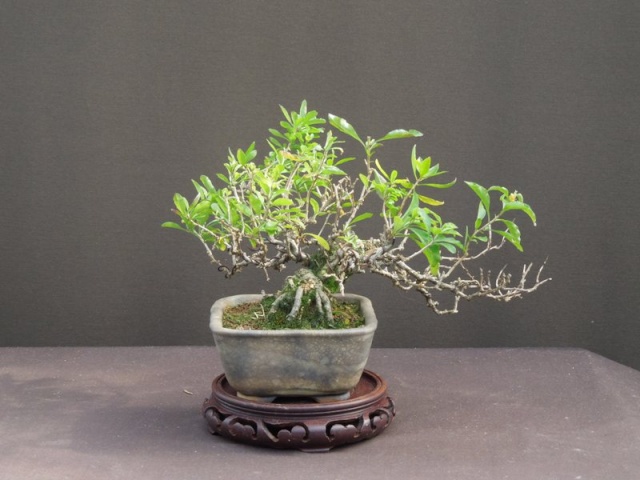
You can see instantly the problem I have with it. It sends out shoots prolifically all over and at the base of its trunk, and these need taken right back. But it's in the lap of the gods whether it will shoot again on old branches, although at least the speed with which it sends out new shoots gives me options for new fronts.
The only other Cuphea I have ever seen anywhere over here is the cultivar "Tiny Mice" (which I think is a llavea cultivar)and it is a summer garden/hanging basket plant which is just not hardy enough to survive even a mild winter here.
I have done little this year other than trim and feed this one in the hope that it might produce a flower. Frankly, it's not worth the hassle here and I won't be desperately upset if it goes. The pot is nice though.





fiona- Member
 Re: Help Please - Cuphea h.
Re: Help Please - Cuphea h.
And I should have said, that is Shohin size - about 6inches height.

fiona- Member
 Re: Help Please - Cuphea h.
Re: Help Please - Cuphea h.
Fiona,
thanks for taking the time to write and post images. The older variety of Cuphea, seen in my earlier image, is the one that produces the 1"+ [ 2.5 cm ] trunk.
Plus many side shoots from the base, which have to be removed as soon as the green is seen.
The other types are more for flowers.
I doubt that they live for longer than 25 years.
They are fun shrubs, make great miniatures, and add colour.
Andre,
on our side, 4 cultivars are all you get. Yes, I know what Billy said, after all I started the topic.
Plus, I am really only after the one that can produce a trunk, so the other 39 are probably of no use to me.
As I said, I will get back to this probably some time next year.
Wish me luck---------------- a 5 cm trunked Cuphea ------- dreammmmmmmmmmmmmmmmmmmmm
Later.
Khaimraj
* Hey a 1' trunk will handle a 6 to 9 inch tall specimen. That's more than okay for me.
thanks for taking the time to write and post images. The older variety of Cuphea, seen in my earlier image, is the one that produces the 1"+ [ 2.5 cm ] trunk.
Plus many side shoots from the base, which have to be removed as soon as the green is seen.
The other types are more for flowers.
I doubt that they live for longer than 25 years.
They are fun shrubs, make great miniatures, and add colour.
Andre,
on our side, 4 cultivars are all you get. Yes, I know what Billy said, after all I started the topic.
Plus, I am really only after the one that can produce a trunk, so the other 39 are probably of no use to me.
As I said, I will get back to this probably some time next year.
Wish me luck---------------- a 5 cm trunked Cuphea ------- dreammmmmmmmmmmmmmmmmmmmm
Later.
Khaimraj
* Hey a 1' trunk will handle a 6 to 9 inch tall specimen. That's more than okay for me.

Khaimraj Seepersad- Member
 Cuphea hyssopifolia - Any update on that topic?
Cuphea hyssopifolia - Any update on that topic?
Andre Beaurain wrote:If anyone is able to grow a cuphea with a 5cm trunk, I will eat my hat.Hello Xtolord,
X if you prefer - Smile
I found out that there are three or four cultivars of the Cuphea, and we now have a yellow flowering one as well.
Read what Billy posted.....there are at least 40 cultivars, not 4!
I know of 6 in our nursery trade, none will ever form thick trunks. I'm talking 5cm.
Love and light
Andre
Hi Andre,
I might find something coming close
I'll take a ruler tomorrow morning and try to get shot
I just hope it is really that thick
The ones I bought are 1cm thick though
Cheers
Xavier

Xavier de Lapeyre- Member
 Re: Help Please - Cuphea h.
Re: Help Please - Cuphea h.
Andre Beaurain wrote:If anyone is able to grow a cuphea with a 5cm trunk, I will eat my hat.
I know of 6 in our nursery trade, none will ever form thick trunks. I'm talking 5cm.
Hi Andre,
The one I saw was only 2.5cm thick... [ it looked bigger until I measured it ]
Its roughtly 3 years old.


Xavier

Xavier de Lapeyre- Member
 Re: Help Please - Cuphea h.
Re: Help Please - Cuphea h.
Dunno about the tree but Xavier de Lapeyre has got to be the coolest member name on the forum. 





fiona- Member
 Re: Help Please - Cuphea h.
Re: Help Please - Cuphea h.
2,5cm ....Halfway there....I'll keep my hat on.
Fiona I agree, its a moviestar name.
Fiona I agree, its a moviestar name.

Andre Beaurain- Member
 Re: Help Please - Cuphea h.
Re: Help Please - Cuphea h.
fiona wrote:Dunno about the tree but Xavier de Lapeyre has got to be the coolest member name on the forum.


lolzz

Andre Beaurain wrote:2,5cm ....Halfway there....I'll keep my hat on.
Fiona I agree, its a moviestar name.
I'm playing with three cuphea right now... well 1 actually, the other 2 are in the ground.
The one I'm playing with is dropping some aerials roots which I am trying to promote further, so that might give a thicker impression to the tree.
Its still thin right now but in some 2~3 years it might get there
Now I just have to be patient and wait

Xavier de Lapeyre- Member
 Re: Help Please - Cuphea h.
Re: Help Please - Cuphea h.
As of 4 weeks ago I found two at just around 1/2 an inch [ 12/13 mm] and they look as though, they might just repeat what I did with my first image posted here.
Probably a fool's errand, but I will try again.
The trunks are clean of shoots and fine rooting, I will try to religiously keep them clean and repot the shrub into gallon containers, but saucers, not pots. Depth of the saucer will probably stay at around 3" [ less than 8 cm]and the soil will probably be stoney.
If anything comes of my experiment,I will post again.
Until.
Khaimraj
* I have been using a type of UV resistant plastic saucer being made down here, by the folk that make the black UV resistant plastic water tanks. The technology is coming out of Canada.
Saucers can reach up to 2'[ 61 cm ]
Seems to be the simplest way to train for life to come in a Bonsai pot.
No problems thus far after a year of use.
Probably a fool's errand, but I will try again.
The trunks are clean of shoots and fine rooting, I will try to religiously keep them clean and repot the shrub into gallon containers, but saucers, not pots. Depth of the saucer will probably stay at around 3" [ less than 8 cm]and the soil will probably be stoney.
If anything comes of my experiment,I will post again.
Until.
Khaimraj
* I have been using a type of UV resistant plastic saucer being made down here, by the folk that make the black UV resistant plastic water tanks. The technology is coming out of Canada.
Saucers can reach up to 2'[ 61 cm ]
Seems to be the simplest way to train for life to come in a Bonsai pot.
No problems thus far after a year of use.

Khaimraj Seepersad- Member
 Re: Help Please - Cuphea h.
Re: Help Please - Cuphea h.
dug these cuphea up from the side fence at my granmas house as the neighbours will be knocking down the fence soon for a renovation. She said she planted them maybe 20 years ago but they never got enough light and kept dying back, only to return with new growth every so often.
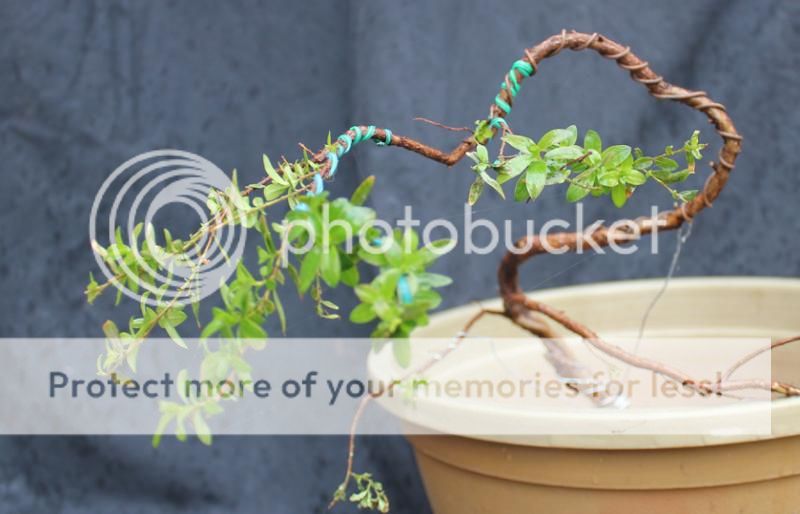
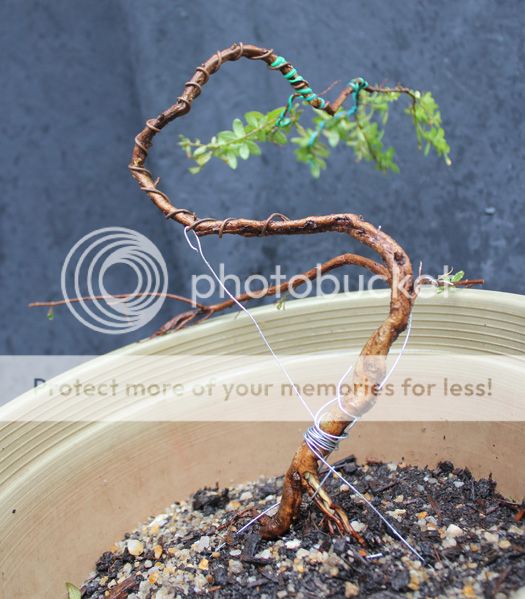
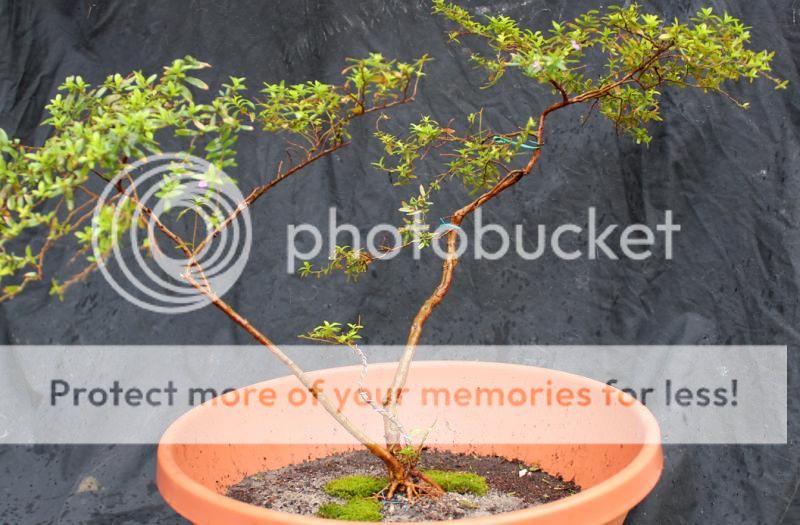

Johanson- Member
 Re: Help Please - Cuphea h.
Re: Help Please - Cuphea h.
Hi Johanson
Welcome to IBC
I'd be interested in how your cuphea will handle the wiring.
I wired one with some daring curves and it died back on me to sprout new growth exclusively at the base.
Let me know if yours is ok so that I know if it was too much curves on my part or just the species that cannot handle extreme curves.
For your last picture, I think is has some potential as a mame :
My reasons for that:
1. You won't be able to get a substantial thickening of the trunk/branches, even if you allow it to grow.
2. I has a tendency to pull leggy growth if left unchecked [ actually the inner branches seems to die off overtime and take ages to re-bud, creating those leggy growths ]
3. You have a nice base, nice root work but the foliage it way too far away. Bring the foliage down closer to the trunk and you'll be able to extract a tree out of it.
If you go by my suggestion, there are some possible issues:
1. The growth/sprouting areas are uncontrollable. You might get loads of adventurous growth lower down or even on the roots instead of on the trunks. DON'T CUT THEM OFF RIGHT AWAY if you do get this pattern. Let if go bushy for some cycles to replenish its reserves and allow the growth to "scale up" the trunk, then start defining the shape.
2. The root growth is extreme in my case, a few foliage growth could result in a pot-bound tree, if you have the same pattern, just be conscious of it to be able to take the necessary precautions.
Welcome to IBC
I'd be interested in how your cuphea will handle the wiring.
I wired one with some daring curves and it died back on me to sprout new growth exclusively at the base.
Let me know if yours is ok so that I know if it was too much curves on my part or just the species that cannot handle extreme curves.
For your last picture, I think is has some potential as a mame :
Personnaly I would have waited for the next growth cycle to start and then chop hard lower down, closer to the roots to create a mame.johanson wrote:
My reasons for that:
1. You won't be able to get a substantial thickening of the trunk/branches, even if you allow it to grow.
2. I has a tendency to pull leggy growth if left unchecked [ actually the inner branches seems to die off overtime and take ages to re-bud, creating those leggy growths ]
3. You have a nice base, nice root work but the foliage it way too far away. Bring the foliage down closer to the trunk and you'll be able to extract a tree out of it.
If you go by my suggestion, there are some possible issues:
1. The growth/sprouting areas are uncontrollable. You might get loads of adventurous growth lower down or even on the roots instead of on the trunks. DON'T CUT THEM OFF RIGHT AWAY if you do get this pattern. Let if go bushy for some cycles to replenish its reserves and allow the growth to "scale up" the trunk, then start defining the shape.
2. The root growth is extreme in my case, a few foliage growth could result in a pot-bound tree, if you have the same pattern, just be conscious of it to be able to take the necessary precautions.

Xavier de Lapeyre- Member
 Re: Help Please - Cuphea h.
Re: Help Please - Cuphea h.
Hi Xavier, thanks for the warm welcome, your comments are much appreciated,Xavier de Lapeyre wrote:Hi Johanson
Welcome to IBC
I'd be interested in how your cuphea will handle the wiring.
I wired one with some daring curves and it died back on me to sprout new growth exclusively at the base.
Let me know if yours is ok so that I know if it was too much curves on my part or just the species that cannot handle extreme curves.
For your last picture, I think is has some potential as a mame :
Personnaly I would have waited for the next growth cycle to start and then chop hard lower down, closer to the roots to create a mame.
My reasons for that:
1. You won't be able to get a substantial thickening of the trunk/branches, even if you allow it to grow.
2. I has a tendency to pull leggy growth if left unchecked [ actually the inner branches seems to die off overtime and take ages to re-bud, creating those leggy growths ]
3. You have a nice base, nice root work but the foliage it way too far away. Bring the foliage down closer to the trunk and you'll be able to extract a tree out of it.
If you go by my suggestion, there are some possible issues:
1. The growth/sprouting areas are uncontrollable. You might get loads of adventurous growth lower down or even on the roots instead of on the trunks. DON'T CUT THEM OFF RIGHT AWAY if you do get this pattern. Let if go bushy for some cycles to replenish its reserves and allow the growth to "scale up" the trunk, then start defining the shape.
2. The root growth is extreme in my case, a few foliage growth could result in a pot-bound tree, if you have the same pattern, just be conscious of it to be able to take the necessary precautions.
Im a bit doubtful aswell if the first plant i posted with the hard wiring will survive, but i thought itd be worth experimenting on. Theres several more old gangly cuphea left at my granma's house for me to dig up, maybe 8-10 in total? So ive got a good amount to play around with, hopefully get 1 or 2 decent trees out of the batch
I like your suggestion of a mame for the second pic i posted, it has some pretty crazy nebari going on under there and i feel they could be really emphasised if i went with your suggestion. When you say chop hard lower downs, should i be chopping off basically the majority of the trunk at almost the base and then using that lower shoot growing from the base as the new leader? Im hesitent to lose that lovely looking twisty trunk, sorry if im asking silly questions

Johanson- Member
 Re: Help Please - Cuphea h.
Re: Help Please - Cuphea h.
Good luck with the experimentation 
I'm seeing only a 2D view from one angle.
You have to look at the roots from all the other angles and decide what you see into it.
From this angle I'm seeing two possible progressions:
1. Twin trunk

2. Single trunk

There might be other alternatives too, but so far those two are what I'm seeing in this material
In this case, I think the nebari is the main criteria that you should consider before you choose the future shape of the tree.Johanson wrote:
I like your suggestion of a mame for the second pic i posted, it has some pretty crazy nebari going on under there and i feel they could be really emphasised if i went with your suggestion. When you say chop hard lower downs, should i be chopping off basically the majority of the trunk at almost the base and then using that lower shoot growing from the base as the new leader? Im hesitent to lose that lovely looking twisty trunk, sorry if im asking silly questions
I'm seeing only a 2D view from one angle.
You have to look at the roots from all the other angles and decide what you see into it.
From this angle I'm seeing two possible progressions:
1. Twin trunk

2. Single trunk

There might be other alternatives too, but so far those two are what I'm seeing in this material

Xavier de Lapeyre- Member
 Re: Help Please - Cuphea h.
Re: Help Please - Cuphea h.
Quite often Photoshop is required for thickening trunks. Try the "Liquify" filter for best results.
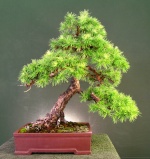
Twisted Trees- Member
 Re: Help Please - Cuphea h.
Re: Help Please - Cuphea h.
hi xavier, thanks again for your thoughts,
heres a few closeup shots i took this morning of the base of the tree from a few angles, after thinking about it i think ill probably go with your second suggestion and just lop off that 2nd trunk once its a bit healthier.
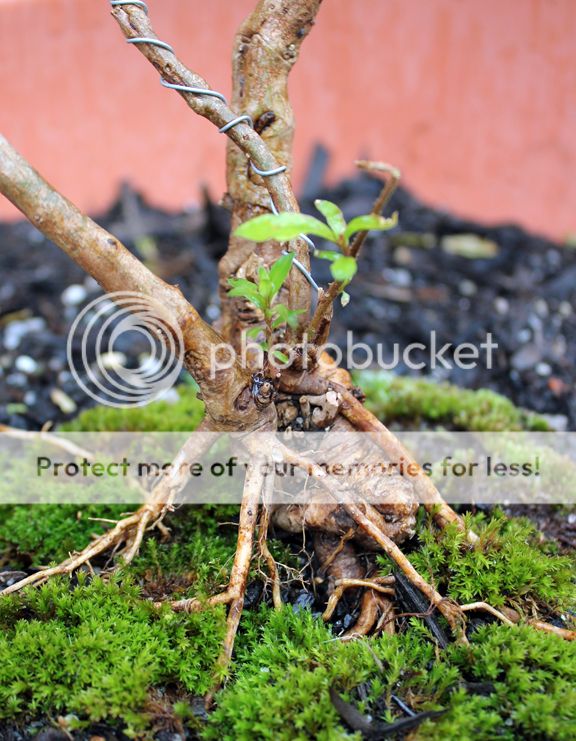
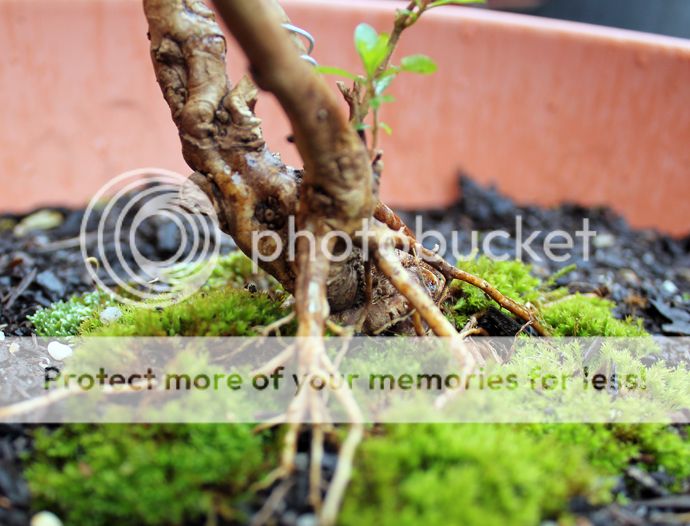
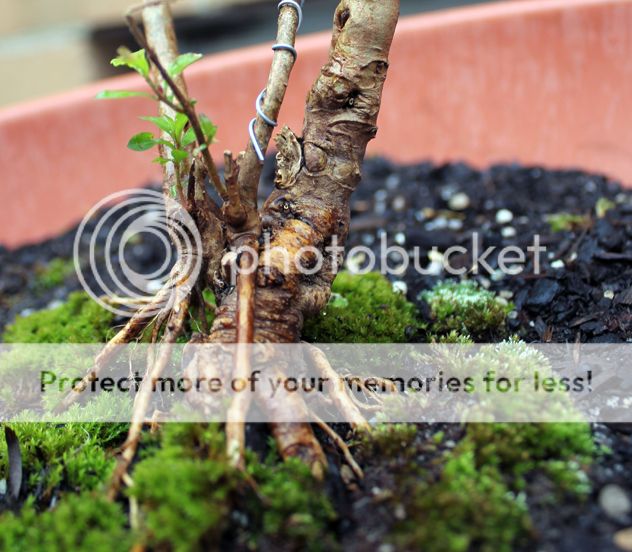
19:07:58
heres a few closeup shots i took this morning of the base of the tree from a few angles, after thinking about it i think ill probably go with your second suggestion and just lop off that 2nd trunk once its a bit healthier.



19:07:58
not sure if joking or are you implying that these have been liquified?Twisted Trees wrote:Quite often Photoshop is required for thickening trunks. Try the "Liquify" filter for best results.

Johanson- Member
 Re: Help Please - Cuphea h.
Re: Help Please - Cuphea h.
Johanson,
a few points to ponder.
[1] The cupheas that get larger trunks are the very old or original stock. The newer types are really more for flowers.
[2] What you have in the images, is a cuphea attempting to become two plants. If you separate, often the main trunk will just start to rot and not heal.
[3] If you cut a cuphea it is safer to have shoots just under the cut, otherwise the branch or trunk will just die.
My suggestion would be just grow them for 3 to 5 years and study the plant. A cuphea needs to remain healthy to do any work on it.
This is why I left my image for you to see.
If you want to work with cupheas, you have to get them to the image I left for you to see.
Try to resist the urge to wire or grow and clip them, they can just die on you.
This is one of those shrubs that has to be understood and healthy to be worked on.
Most just grow mame' and then find something else to grow.
Best to you.
Khaimraj
* Been growing Cuphea since 87, and still don't fully understand them. The under 8cm give the least amount of trouble. With deep purple, being the easiest, the white next and the light purple being a pain. There is also a yellow, but that is yet another kettle of fish.
a few points to ponder.
[1] The cupheas that get larger trunks are the very old or original stock. The newer types are really more for flowers.
[2] What you have in the images, is a cuphea attempting to become two plants. If you separate, often the main trunk will just start to rot and not heal.
[3] If you cut a cuphea it is safer to have shoots just under the cut, otherwise the branch or trunk will just die.
My suggestion would be just grow them for 3 to 5 years and study the plant. A cuphea needs to remain healthy to do any work on it.
This is why I left my image for you to see.
If you want to work with cupheas, you have to get them to the image I left for you to see.
Try to resist the urge to wire or grow and clip them, they can just die on you.
This is one of those shrubs that has to be understood and healthy to be worked on.
Most just grow mame' and then find something else to grow.
Best to you.
Khaimraj
* Been growing Cuphea since 87, and still don't fully understand them. The under 8cm give the least amount of trouble. With deep purple, being the easiest, the white next and the light purple being a pain. There is also a yellow, but that is yet another kettle of fish.

Khaimraj Seepersad- Member
 Re: Help Please - Cuphea h.
Re: Help Please - Cuphea h.
Not sure if I'm joking?Johanson wrote:not sure if joking or are you implying that these have been liquified?Twisted Trees wrote:Quite often Photoshop is required for thickening trunks. Try the "Liquify" filter for best results.

Twisted Trees- Member
Page 1 of 2 • 1, 2 
Page 1 of 2
Permissions in this forum:
You cannot reply to topics in this forum







